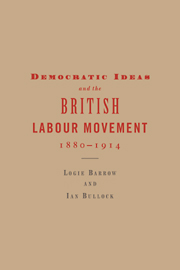Book contents
5 - The pressure to federate: the industrial struggle in the late 1890s
Published online by Cambridge University Press: 09 November 2009
Summary
The Clarion's association with campaigns for direct democracy and against ‘leaders' was surely one reason why P. J. King offered the paper his scheme for trades federation. But what swiftly became known as the ‘Clarion scheme ’ would not have come so close to success without the turmoil that the trade union movement found itself in by the later 1890s.
Compared with the 1880s, the movement of the 1890s was characterised not only by wider numbers but also by widening insecurity. This is a key feature. The economic downswing of the early 1890s had seen, in many sectors, an employers ’ counter-attack. This had left much of the New Unionism either gutted or dependent on stand-down agreements, explicit or otherwise, with particular employers or groups of employers.
Older unions likewise found their gains coming under pressure. If the ensuing years saw – according to most economic historians – a slow recovery in average real wages, they also saw a number of set-piece conflicts: the mining lock-out, the Lancashire cotton-spinners ’ struggle and the Hull dock strike during 1893; the engineering struggle on Clydeside and in Belfast (1895-6); South Wales mines (1898); Scottish Furniture Trades (1898-9) and above all the London – but soon almost national – struggle in the engineering industry (July 1897-January 1898).
Faced with such threats, the New Unions must have seemed somewhat contingent to their members – in their survival as in their beginnings.
- Type
- Chapter
- Information
- Democratic Ideas and the British Labour Movement, 1880–1914 , pp. 88 - 108Publisher: Cambridge University PressPrint publication year: 1996



